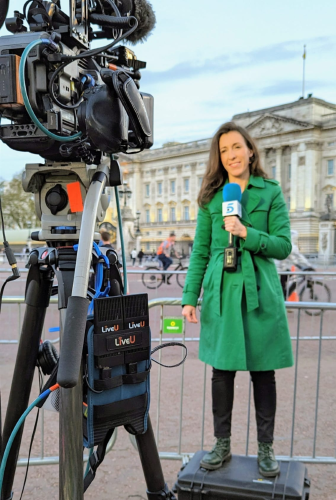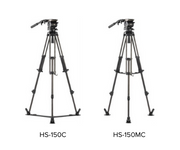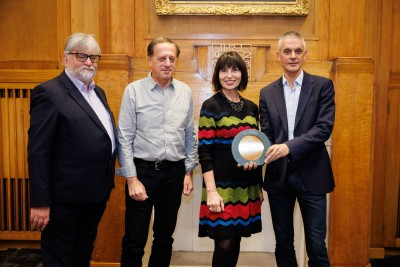Miller Camera Support has never been more thoroughly tested than by Australian Cinematographer Wade Fairley, through Antarctic winters and summers, floods in Tuvalu, swamps in the Solomon Islands and the outback deserts of Australia. The most outstanding project of recent times for Wade was the trip for the BBC Natural History Unit, shooting footage for Planet Earth.
Wade Fairley, intrepid Antarctophile headed off for the year with a range of Miller Camera Support products including the DS60 150mm Fluid Head and Tripod System, Projib Jib arm and DS5 DV system on the extensive project for the BBC Natural History Unit, shooting the breeding habits of Emperor Penguins. Wade’s principal mission was to record in unprecedented detail, on 35 mm film, the incredible breeding cycle of the emperor penguin.
These remarkable birds raise a chick through the depth of the Antarctic winter, fasting throughout, gathered in sophisticated social structures or ‘huddles’ to conserve heat. The Auster Rookery on Macey Island was Wade and his partner Frederique’s home for a year.
The best footage of the bird’s incredible survival was shot in the worst winter weather, during temperatures down to – 40 Celsius and howling blizzards. It was a shoot with vast technical challenges, including the need for a rock steady camera support in the fiercest winds. The project exposed Miller Camera Support gear to an unprecedented field test as all of the filming was field based, in one of the most dramatic locations on earth.
In feedback from the Antarctic winter, Wade emailed his thoughts about how the Miller tripods were surviving the extreme cold: “Throughout the Antarctic winter, Miller tripods proved a steady rock in the sea of howling wind and snow. Most of the blizzard work was done on a 600 mm lens (it's extra important to keep at least 50 meters distance from the penguins when they're huddled because a sharp movement or scare could cause the huddle to split, the result is stampede-like as birds move out of the crush and drop their eggs) and the need for a super steady platform exaggerated by this distance and wind was considerable. The camera on DS60 locked off beautifully, my head though I had less control over. Clad in a down hood and ruff (a fur rim to protect the eyes and face), in 40+ knots of wind, the combination like a spinnaker! This caused my eye to bob against the viewfinder, vibrating the camera with each knock. Many shots I simply had no choice but to lock off the tripod, close the eyepiece and roll remotely.”
Since spending a year in freezing temperatures, Wade’s follow up project was a little more tropical on the island of Tuvalu, again with Miller Tripods supporting the shoot. Wade set off for BBC Science to record the events surrounding the King Tide that occurred with the new moon in Tuvalu. During the day, the island’s Bureau of Meteorology - who’ve been collecting tide data on the island for the past 24 years - recorded their highest tide on record, peaking at 3.42 meters (the average is about 2.5m) and during this time much of Funafuti (Tuvalu’s most heavily populated island) flooded.
A set of Solo Legs and Arrow head were the perfect tools for this job – light weight enabling Wade to move relatively easily about the island, but with the precise movement and handling for the production standards the job demanded. Not to mention rough and tumble design too. The tripod needed to cope with being immersed in sea water, carried in small open boats, heat and humidity, sand and rough treatment. At the end of the day, cleaning was simple and the locking function was always perfect.
The same Arrow Solo system was put through more of the same ‘tropical treatment’ in the jungles of Papua New Guinea and the Solomon Islands. Shooting in waist deep mud, for the recovery of a World War II B-17 Bomber plane.
Always the adventurers, Wade and Fred’s latest adventure to Macquarie Island Nature Reserve is one of the most valuable reserves in Australia. A World Heritage Area, it is also listed as an International Biosphere Reserve.
This tiny island located 700 miles south of Tasmania gets its name due to the lush vegetation, which grows in constant rain, wind and the less than 5 sunny days per year that the climate has to offer! But the green sponge has turned yellow, not due to the lack rain, but under the pressure of the invasive growth of rabbit and rat populations on the island.
Macquarie Island is hell for camera gear. The black volcanic sand (commonly called grit!) penetrates every interstice and stays there because it’s wet and sticky! No exception was made for the Arrow Solo System which Wade and Fred carried everywhere by foot. Walking is the only means of transport on Macquarie Island, and it is rugged! Between steep grassy hills or windy rocky shores covered in slippery kelp, a lightweight tripod was the best to help the adventurers cover some ground safely! And its fast deployment helped catch the light between the many rain showers.
The material shot on this latest project reached the media after their return and was used to encourage the Tasmanian State Government to support and finance the eradication program, which is now going ahead. It apparently is the largest feral pest eradication program attempted in the world to date. Wade and Fred hope it will succeed and protect the unique World Heritage values of the island.
Through ice, snow, sand, mud, sea-water, grit and transportation around the world, Wade Fairley and his Miller Camera Support Equipment are off again to shoot more adventurous award-winning scenes and Miller will be there to support the adventure come hell or high-water!






























